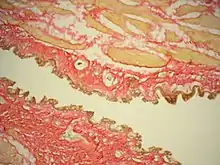Van-Gieson-Färbung
Die Van-Gieson-Trichrom-Färbung ist eine histologische Färbemethode, die teilweise auch als Trichrom-Färbung eingesetzt wird.[1]

Bronchien des Vogelstraußes, nach Van Gieson gefärbt.
Eigenschaften
Die meisten Varianten der Van-Gieson-Färbung bestehen aus einer einstufigen Färbung mit wässriger, gesättigter Pikrinsäurelösung und Säurefuchsin. Sie gehört zu den Picro-Fuchsin-Färbungen.[2] Sie wird zur Färbung von Kollagen und Bindegeweben verwendet,[3] teilweise auch in Kombination mit einer Elastika-Färbung (Elastika-Van-Gieson-Färbung).
Geschichte
Die Van-Gieson-Färbung wurde im Jahr 1889 von Ira Van Gieson (1866–1913) entwickelt und wurde in der Folge nach dem Erfinder benannt.[1]
Literatur
- J. Bancroft, M. Gamble: Theory and Practice of Histological Techniques. 6. Auflage, Churchill-Livingstone, London 2008.
- B. Bricegirdle: A History of Microtechnique. 2. Auflage, Science Heritage Ltd, Chicago 1986.
- F. L. Carson: Histotechnology A Self Instructional Text. 2. Auflage, ASCP Press, Chicago 1997.
- D. Sheehan, B. B. Hrapchak: Theory and Practice of Histotechnology. 2. Auflage, Mosby, St. Louis 1980.
Weblinks
- Bryan D. Llewellyn: Differential Staining With Acid Dyes. PDF.
Einzelnachweise
- Ira van Gieson: Laboratory notes of technical methods for the nervous system. In: N Y Med J. (1889), Band 50, S. 57.
- Peter Gray: The Microtomist's Formulary and Guide. (1954). Ursprünglich von The Blakiston Co., später Robert E. Krieger Publishing Co.
- I. Singh: A simple substitute of iron haematoxylin in the van Gieson- and Masson-trichrome procedures. In: Anatomischer Anzeiger. Band 124, Nummer 5, 1969, ISSN 0003-2786, S. 490–491, PMID 4185232.
This article is issued from Wikipedia. The text is licensed under Creative Commons - Attribution - Sharealike. The authors of the article are listed here. Additional terms may apply for the media files, click on images to show image meta data.